calotta; dome; drum; lantern
dome (also called cupola after the same Italian word) means the rounded vault of a temple (Pantheon) and later on of
churches and palaces.
It can be distinguished in three parts:
a) drum (A) often having a polygonal shape and with thick walls to support the weight of the
b) calotta (B) the curved section of the dome which is often composed of an inner and an outer calotta;
c) lantern (C) a small and decorated structure with windows.
The image shows the dome of S. Maria del Fiore in Florence designed by Filippo Brunelleschi. | 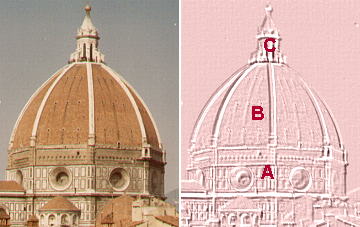 |
capital; order
Greek temples were designed according to three standard modules (order) which mainly differed in the design of the capital, the upper part of the column immediately below the architrave.
The earliest design is called Doric order and it was followed by the Ionic order (characterized by two volutes) and
by the Corinthian order (decorated with acanthus leaves). The Romans combined Ionic and Corinthian orders
in an order called composite.
The images show (left to right): a Doric capital in the Parthenon of Athens;
a Ionic capital of a temple in Veii now in Piazza Colonna in Rome; a composite capital of
Olimpieion in Athens. |  |
cartouche
a cartouche is a decorative tablet imitating a scroll with rolled-up ends, usually bearing
an inscription. Gian Lorenzo Bernini designed a gigantic cartouche in S. Maria in Aracoeli.
The image shows a cartouche above the entrance
of Collegio Ghislieri in Via Giulia in Rome. |  |
caryatid
According to Robert Graves (The Greek Myths), Carya, daughter of a Laconian king, was beloved of Dyonisus,
but died suddenly and was metamorphosed by him into a walnut-tree. Artemis brought the news to the Laconians, who built a temple to Artemis
Caryatis, from which caryatids - female statues used as columns - take their name. The image shows the decorative caryatids of
Scloss Sanssouci in Potsdam, Germany.
A male figure is called atlantes. | 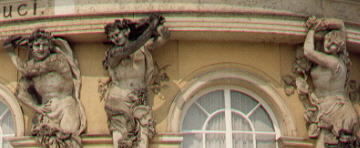 |
cassettone
a cassettoni is the Italian locution characterizing a Renaissance
wooden ceiling divided into deep cavities.
At the beginning of the Renaissance the cavities had a regular shape, but later on a more elaborated
design prevailed together with a richly painted and gilded decoration.
See some other ceilings of this type.
The image shows the ceiling of S. Grisogono decorated with the heraldic
symbols of Cardinal Scipione Borghese Caffarelli. | 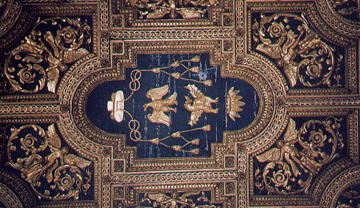 |
centaur; satyr
centaur in Greek mythology is a horse with the body, the arms and the face of a man;
perhaps a reference to archaic moon dances by men disguised as horses. Centaurs are often shown in battle scenes.
satyrs are mythological woodland half goat half human deities. They are usually portrayed in lewd attitudes.
The images show a satyr and a centaur in the reliefs
in the courtyard of Palazzo Spada in Rome. | 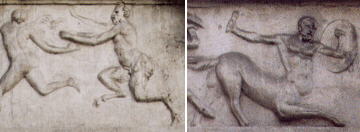 |
cornucopia
Cornucopia is one of the horns of Amaltheia, the goat-nymph who nursed Zeus.
She gave it to Zeus who presented it to Adrasteia and Io, two other nymphs: it became the horn of plenty (Latin: cornus=horn, copia=abundance), which is always filled with whatever food or drink its owner may desire.
A very common decoration theme, cornucopia is often shown in a very standardized way (see the cornucopias in Porta del Popolo in Rome).
An exception is the long cornucopia held by the River Tiber
in a colossal statue now in Piazza del Campidoglio in Rome. | 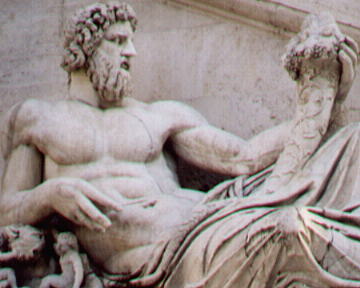 |
Cosmati work
Cosmati is the generic name given to families of Roman decorators who made use of pieces of marbles and other
stones which had been part of Roman temples and buildings.
Their activity spanned from the beginning of the XIIth century to the end of the XIIIth century. A recurring design is a spiral around a disc of red porphyry.
The best examples of
Cosmati works can be found in the cloister of S. Paolo fuori le Mura, in the portico
of the Cathedral of Civitacastellana and in the pavements
of several churches in Rome.
The image shows a detail of the pavement of S. Maria in Cosmedin in Rome.
| 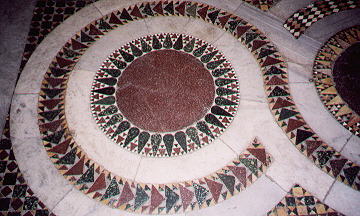 |
gisant
gisant is a word of French origin used with reference
to funerary monuments where the deceased is portrayed lying on the lid of a sarcophagus having the shape of a bed.
For a page on the funerary monuments to the popes click here.
The image shows a detail of the monument to the English Cardinal of Hartford in S. Cecilia in Rome. |  |
graffito; grotesque
graffito means scratched and it defines a drawing technique based on two colours which gives the impression to the
viewer that the colour on the surface is scratched in order to show a different colour under it.
grotesque is
a decorative theme used by the Romans and rediscovered at the beginning of the XVIth century
in the ruins of Nero's Domus Aurea. Because the ruins had the appearance of caves (It. grotta) the decorations were
called grotesque. They show small figures of men and animals, foliage and amorini, often arranged to form
a sort of chandelier (candelabra).
The image shows a detail of Palazzo Vitelli della
Cannoniera in Cittą di Castello. | 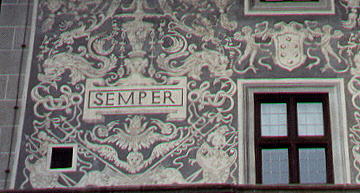 |


 or to
The Coats of Arms of the Popes or
to My Home Page on Baroque Rome or to
My Home Page on Rome in the footsteps of an XVIIIth century traveller
or to
The Coats of Arms of the Popes or
to My Home Page on Baroque Rome or to
My Home Page on Rome in the footsteps of an XVIIIth century traveller









